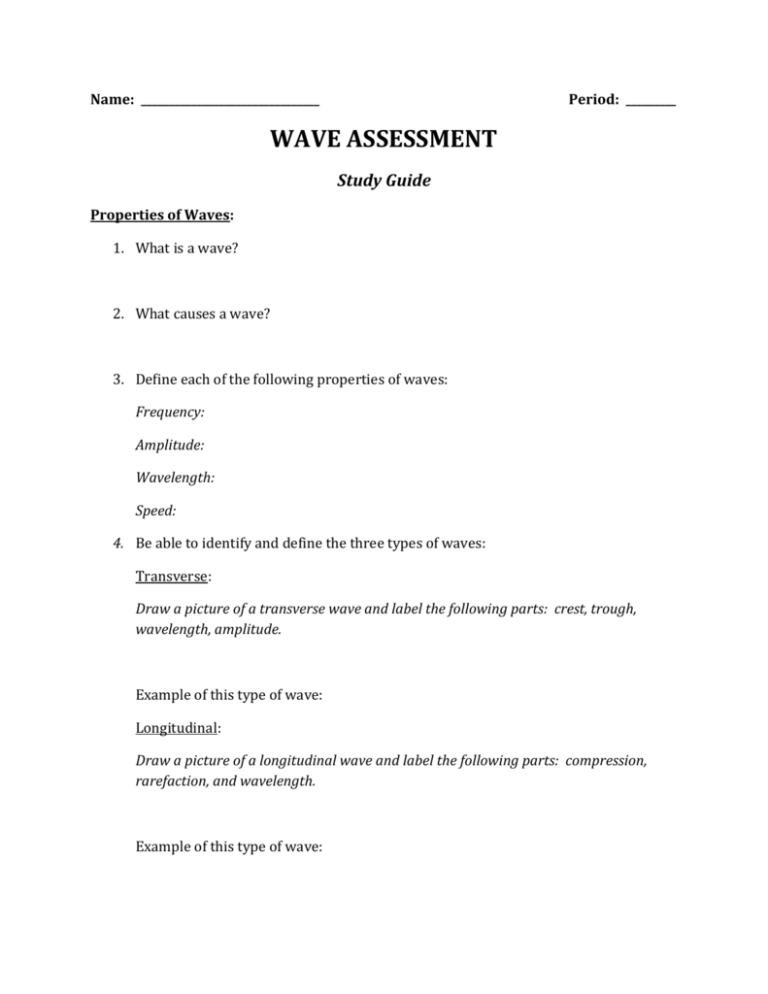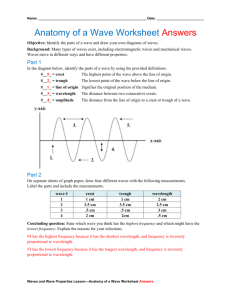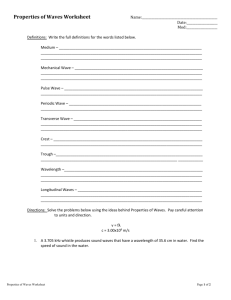Wave Test Review sheet
advertisement

Name: ________________________________ Period: _________ WAVE ASSESSMENT Study Guide Properties of Waves: 1. What is a wave? 2. What causes a wave? 3. Define each of the following properties of waves: Frequency: Amplitude: Wavelength: Speed: 4. Be able to identify and define the three types of waves: Transverse: Draw a picture of a transverse wave and label the following parts: crest, trough, wavelength, amplitude. Example of this type of wave: Longitudinal: Draw a picture of a longitudinal wave and label the following parts: compression, rarefaction, and wavelength. Example of this type of wave: Surface Waves: Example of this type of wave: 5. What types of waves do not require a medium? Give an example of one kind of energy that exists as this type of wave. 6. Compare sound and light waves. How are they alike and how are they different? Similarities Differences Matching: 7. _______ the material through which waves travel 8. _______ waves that can be seen by humans 9. _______ the highest part of a wave 10. _______ the lowest part of a wave 11. _______ when two waves meet and a larger amplitude results 12. _______ when two waves meet and cancel each other out a. b. c. d. e. trough constructive interference destructive interference visible light sound energy f. crest Fill-In the Blank: 10. To increase the amplitude of a wave, you must first increase ________________________. 11. _______________________ occurs when a wave hits a surface and bounces back. 12. When two or more waves meet, _________________________ occurs. 13. _______________________ occurs when a wave passes a barrier or hole and it bends and spreads out. 14. When a moving wave changes speed when it goes from one medium to another and bends, this is called __________________________. Electromagnetic Spectrum: Study the electromagnetic spectrum. http://science.hq.nasa.gov/kids/imagers/ems/ Use the Electromagnetic Spectrum to identify the following: 15. Which wave has the highest frequency? _________________________________ 16. Which wave has the lowest frequency? _________________________________ 17. Which wave has the longest wavelength? ________________________________ 18. Which wave has the shortest wavelength? ________________________________ 19. What colors make up the spectrum? __________________________________ 20. Which color of visible light has the shortest wavelength? ______________________________ 21. Which color of visible light has the longest wavelength? ______________________________ 22. Where does visible light fall within the spectrum? _______________________________ 23. Does light require a medium to travel? Explain your answer. Seismic Waves: 24. Explain how an earthquake is caused. 26. Explain what an S wave and a P wave are in relation to an earthquake. Study handouts that were given: vocabulary, notes, wave diagrams, homework, and bellringers. Review your graphing guidelines!!






